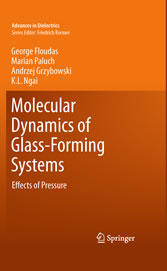Suchen und Finden
Service

Molecular Dynamics of Glass-Forming Systems - Effects of Pressure
George Floudas, Marian Paluch, Andrzej Grzybowski, Kai Ngai
Verlag Springer-Verlag, 2010
ISBN 9783642049026 , 176 Seiten
Format PDF, OL
Kopierschutz Wasserzeichen
Geräte
Preface
8
Contents
12
Chapter 1: The Glass ``Transition´´
14
1.1 Introduction
14
1.2 Pressure Dependence of the Structural (a-) Relaxation Time
18
1.3 The Glass Transition Temperature
30
1.4 The Concept of Fragility
33
1.5 Relative Importance of Thermal Energy and Density
36
Appendix1
42
Appendix2
42
References
47
Chapter 2: Origin of Glass Formation
51
2.1 Thermodynamic Scaling of Molecular Dynamics in Viscous Systems
51
2.1.1 A General Idea of Thermodynamic Scaling
51
2.1.2 A New Measure of the Relative Temperature-Volume Influence on Molecular Dynamics
54
2.1.3 The Relaxation Time Description in Accordance with Thermodynamic Scaling
59
2.1.4 Thermodynamic Scaling on Isothermal Conditions and Its Consequences
64
2.1.5 Doubts About the Thermodynamic Scaling Universality
67
2.2 The Role of Monomer Volume and Local Packing on the Glass-Transition Dynamics
73
References
76
Chapter 3: Models of Temperature-Pressure Dependence of Structural Relaxation Time
78
3.1 The Generalized Vogel-Fulcher-Tammann Equation
78
3.2 The Adam-Gibbs Model
79
3.3 The Avramov Model
82
3.4 Cluster Kinetics Model
86
3.5 Defect Diffusion Model
90
3.6 Dynamic Lattice Liquid Model
95
References
98
Chapter 4: New Physics Gained by the Application of Pressure in the Study of Dynamics of Glass Formers
100
4.1 Dynamics Under Pressure
100
4.2 General Dynamic Properties of Glass Formers Discovered by Applying Pressure
101
4.2.1 Coinvariance of taua and Width of Dispersion to Changes in P and T
101
4.2.2 Crossover of T or P Dependence of ta (or h ) at the Sameta (or h ) Independent on T, P, and V at the Crossover
104
4.2.2.1 Experimental Facts
104
4.2.2.2 Coupling Model Explanation
106
4.2.3 An Important Class of Secondary Relaxations Bearing Strong Connection to the a-Relaxation
109
4.2.3.1 Spin-Lattice Relaxation Weighted Stimulated-Echo Spectroscopy
110
4.2.3.2 Invariance of the Ratio tauJG /taua for Different T and P When taua Is Kept Constant
110
4.2.3.3 TVgamma-Dependence of tauJG
114
Evidence Indicating T-1V-gamma: Dependence Originating from the Primitive Relaxation
114
4.2.3.4 Dependences of the Global and Segmental Dynamics in Polymers on TVgamma: Same gamma but Different Functional Forms
115
4.2.3.5 Change of T-Dependence of JG beta-Relaxation Time and Relaxation Strength on Crossing Tg
116
4.2.3.6 Relation Between the Activation Energies of tauJG and taua in the Glassy State
117
4.2.3.7 Pressure-Temperature History Dependence of tauJG in the Glassy State
117
4.2.3.8 JG beta-Relaxation Causes Cage Decay and Terminates the Nearly Constant Loss
122
4.2.3.9 JG beta-Relaxation Is Responsible for the Anomalous T-Dependence of gamma-Relaxation Time
123
4.3 Conclusions
126
References
127
Chapter 5: Pressure Effects on Polymer Blends
132
5.1 Theoretical Background
132
5.2 Effect of Pressure on the Dynamics of Miscible Polymer Blends: Dynamic Heterogeneity
134
5.2.1 Athermal Polymer Blends/Copolymers (PI-PVE, PMMA/PEO)
136
5.2.1.1 PI-b-PVE
136
5.2.1.2 PMMA/PEO
138
5.2.2 Miscible But Not Athermal Polymer Blends (PS/PMPS, PS/PVME, and PCHMA/PaMS)
142
5.2.2.1 PS/PMPS
143
5.2.2.2 PS/PVME
147
5.2.2.3 PCHMA/PaMS
150
5.2.3 Polymer Blends with Strong Specific Interactions
151
5.3 Effect of Pressure on Nanophase Separated Copolymers
152
5.3.1 PMVE-b-PiBVE
153
5.3.2 pODMA-b-ptBA-b-pODMA
155
References
157
Chapter 6: Polypeptide Dynamics
159
6.1 Introduction
159
6.2 Polypeptide Liquid-to-Glass ``Transition´´ and its Origin
160
6.3 Correlation Length of a-Helices
169
6.4 Effects of Nanoconfinement on the Peptide Secondary Structure and Dynamics
172
6.4.1 ``Soft´´ Confinement: Confinement Within the Nanodomains of Block Copolypeptides
172
6.4.2 ``Hard´´ Confinement: Confinement Inside Nanoporous Anodic Aluminum Oxide
173
6.5 Conclusion
176
References
177
Index
179
Service
Shop


